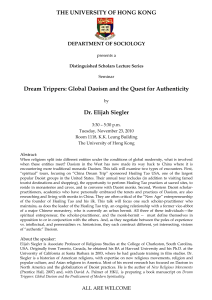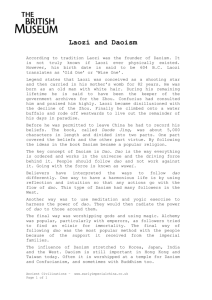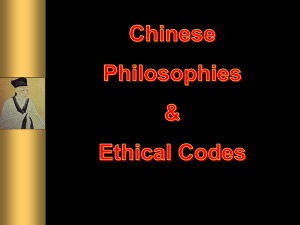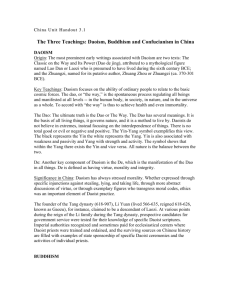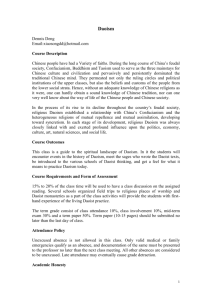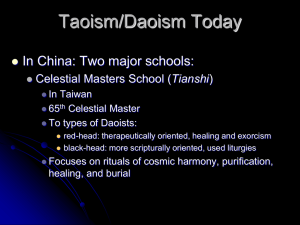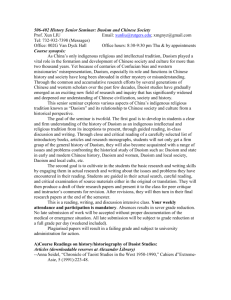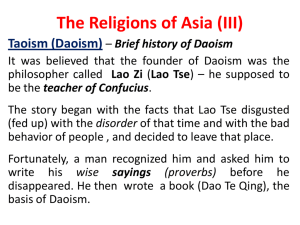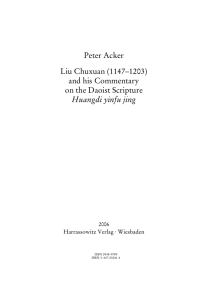10 Notes on DAOISM - Phils Articles about China, Tibet and
advertisement
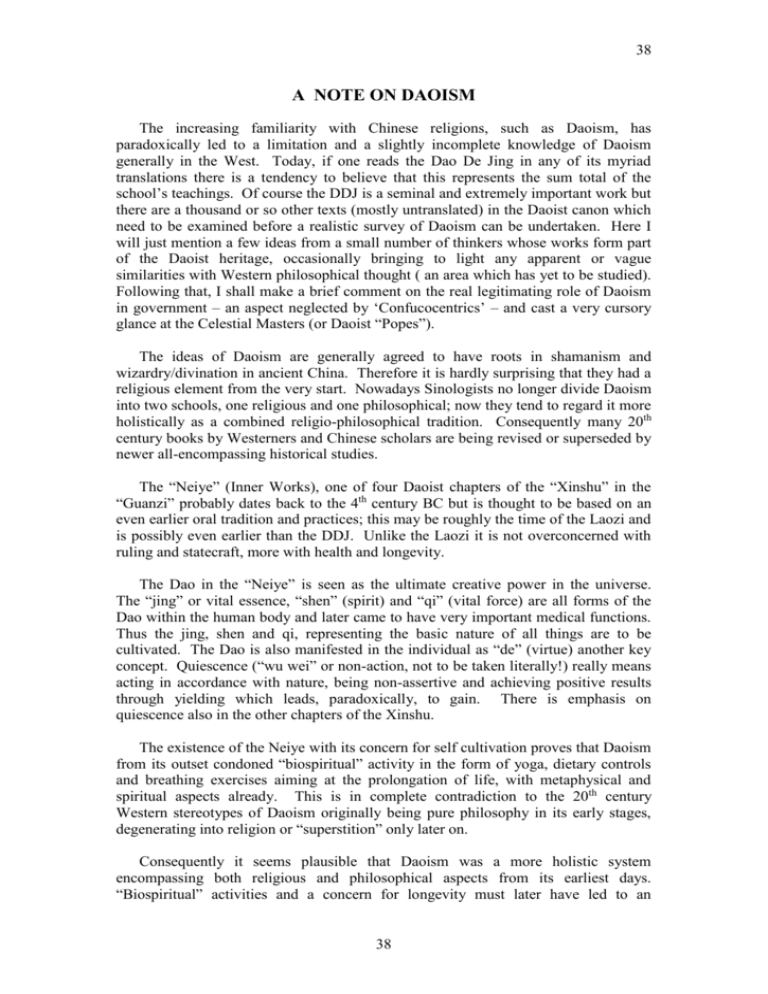
38 A NOTE ON DAOISM The increasing familiarity with Chinese religions, such as Daoism, has paradoxically led to a limitation and a slightly incomplete knowledge of Daoism generally in the West. Today, if one reads the Dao De Jing in any of its myriad translations there is a tendency to believe that this represents the sum total of the school’s teachings. Of course the DDJ is a seminal and extremely important work but there are a thousand or so other texts (mostly untranslated) in the Daoist canon which need to be examined before a realistic survey of Daoism can be undertaken. Here I will just mention a few ideas from a small number of thinkers whose works form part of the Daoist heritage, occasionally bringing to light any apparent or vague similarities with Western philosophical thought ( an area which has yet to be studied). Following that, I shall make a brief comment on the real legitimating role of Daoism in government – an aspect neglected by ‘Confucocentrics’ – and cast a very cursory glance at the Celestial Masters (or Daoist “Popes”). The ideas of Daoism are generally agreed to have roots in shamanism and wizardry/divination in ancient China. Therefore it is hardly surprising that they had a religious element from the very start. Nowadays Sinologists no longer divide Daoism into two schools, one religious and one philosophical; now they tend to regard it more holistically as a combined religio-philosophical tradition. Consequently many 20th century books by Westerners and Chinese scholars are being revised or superseded by newer all-encompassing historical studies. The “Neiye” (Inner Works), one of four Daoist chapters of the “Xinshu” in the “Guanzi” probably dates back to the 4th century BC but is thought to be based on an even earlier oral tradition and practices; this may be roughly the time of the Laozi and is possibly even earlier than the DDJ. Unlike the Laozi it is not overconcerned with ruling and statecraft, more with health and longevity. The Dao in the “Neiye” is seen as the ultimate creative power in the universe. The “jing” or vital essence, “shen” (spirit) and “qi” (vital force) are all forms of the Dao within the human body and later came to have very important medical functions. Thus the jing, shen and qi, representing the basic nature of all things are to be cultivated. The Dao is also manifested in the individual as “de” (virtue) another key concept. Quiescence (“wu wei” or non-action, not to be taken literally!) really means acting in accordance with nature, being non-assertive and achieving positive results through yielding which leads, paradoxically, to gain. There is emphasis on quiescence also in the other chapters of the Xinshu. The existence of the Neiye with its concern for self cultivation proves that Daoism from its outset condoned “biospiritual” activity in the form of yoga, dietary controls and breathing exercises aiming at the prolongation of life, with metaphysical and spiritual aspects already. This is in complete contradiction to the 20th century Western stereotypes of Daoism originally being pure philosophy in its early stages, degenerating into religion or “superstition” only later on. Consequently it seems plausible that Daoism was a more holistic system encompassing both religious and philosophical aspects from its earliest days. “Biospiritual” activities and a concern for longevity must later have led to an 38 39 association with alchemical pursuits aimed at immortality, or rather, transcendence (‘xian’ which does not just entail immortality within this life as used to be thought in the West but also post-mortem transcendence or divinisation). These alchemical practices lead to the advance and development of Chinese science. As for the Xinshu, here vacuity, formlessness and unprejudiced impartiality are advocated, as preconceptions lead to anxiety. The goal is to fit oneself to each occasion as a shadow does to a form or an echo responding to a voice. One needs to be in accord with and prepared for “Great Brilliance” (Yin Zhizhang), like the sageruler. Flexibility in someone who grasps the One gives power over all things like a prince reflecting brightness like the sun and moon. Quiescence (wu wei) governs respect which is controlled by rites of propriety, which moderate music, which in turn alleviates sorrow, caused by poetry, which relieves anger. So wu wei is the means to follow the Way. The Laozi will only briefly be alluded to here as it is so well known. Laozi (Old Master) is obviously non-historical and fictitious and the work bearing his name, like the later Zhuangzi, is the product of more than one hand. Of central importance again is the notion of wu wei - acting in accordance with nature or quiescence. The negative and feminine aspects of life are extolled to the detriment of the positive and masculine - this is seen as paradoxically productive. In political terms, and it should be remembered that the DDJ was intended as a book of statecraft for a sage-ruler, non-intervention and a laissez-faire, almost physiocratic policy is encouraged. Primitivism is also a feature of the DDJ, even to the extent of recommending reverting to rope-knotting instead of writing! Balance, harmony and naturalness are key concepts in Daoism. Of course there are no real parallels in Western thought but Rousseau’s romantic stance might bear a slight resemblance. One notion in the DDJ that does appear to have a Western corollary is that of the unity of opposites, very much part of Daoism and the Chinese philosopher Huizi (370 - 319BC) and a fundamental part of the pre-Socratic philosopher Heraclitus’s thought (this could be an interesting area to study). Holism is another important concept in Daoism: there is no self-other dichotomy (similar to the doctrine of no-self in Buddhism) and everything is interlinked in a subtle way. For example the Dao pervades all things in heaven and earth; the boundaries between inanimate and animate nature are blurred as everything is “organically” one through the action (or non-action!) of the Dao in an almost hylozoist manner. Individuation or differentiation, therefore, is ultimately fallacious; Schopenhauer had a very similar view and would have agreed. Zhuangzi (possibly 369 - 286 BC) was an important practitioner of mystical Daoism. He derided language, logic and knowledge in favour of spontaneity. Unlike Laozi he was not interested in government and often debunked social conventions and received wisdom. The Zhuangzi is a wonderful receptacle of his colourful stories, anecdotes and jokes. The Dao, then, is ineffable and not reducible to language; its inexpressibility and extralinguistic nature recall Wittgenstein’s dictum; “Whereof one cannot speak, thereof one must remain silent” (cf. “the Dao that can be expressed is not the eternal 39 40 Dao”). The early mystically inclined Wittgenstein deliberately undermines his own philosophy as nonsense, as surely Zhuangzi would have done. Zhuangzi opposes civisilation to Nature (the capital Dao or Da Ziran) he prefers to just “drag his tail in the mud” extolling the dissolution of the state and its reconstruction through inner nature (“xing”). His sage lives off the wind and dew: “he climbs and rides the dragons and travels beyond the boundaries of the known world”, and is nourished by yin and yang in the words of one of his mouthpieces. Zhuangzi spontaneously and intuitively knows that fish enjoy swimming and surfacing when it pleases them – floating freely like the Dao – this is like a kind of parable. The Dao is everywhere and all-pervading “even in excrement and urine”. Knowledge and power are to be avoided as they impose a false and forced structure on reality. When Huizi saw Zhuangzi not long after the death of his wife, he was shocked to discover him bashing a battered tub and singing away. But as Zhuangzi goes on to explain, life and death are merely a series of transformations like the succession of the seasons which constitute the unity of existence and non-existence: before conception and formation after birth, during life, at and after death. In a similar vein he states that from water come plants, which become maggots, then butterflies, which turn into insects and then birds. “Green Peace Plants” engender leopards the latter produce horses, then horses become humans in the chain of nature. Innocence, purity, spontaneity and naturalness are to be practised ; the idea is to go with the flow of events, like a baby. It is difficult to date the Liezi accurately; in its present form it appears to be a neoDaoist work of the 3rd or 4th century AD but in inspiration it goes back much further, maybe as far back as the 3rd or 4th century BC. Thus it was probably compiled over a very lengthy period, possibly originating sometime in the Han dynasty. Like the Zhuangzi, it is a hugely popular work, very colourful and readable. A new emphasis on fatalism is apparent in this work, sometimes reminiscent of the Ajivakas of India or the Stoics’ submissive attitude towards divine providence. For Liezi fate and destiny are preferable to choice and effort: spontaneity rules. “If you fall ill, don’t bother to call a doctor; you will recover if you are destined to recover” The Yangzhu chapter within the Liezi is even more radical, expressing hedonism with the pessimism and fatalism. One is encouraged to enjoy this life and not be concerned with any afterlife, for death is just the transformation and transfiguration of the Dao, after all. One should enjoy life to the full and find happiness in “fine clothes, music and beautiful women”. In a startling example of his hedonism, Yangzhu states that he would not give a hair on his head to save the world! Yangzhu actually was a real historical character c.350 BC or even before, an early Daoist, but the ideas attributed to him may be apocryphal. As with earlier Daoist thinkers, Liezi did not believe in the separate existence of the self: “Individual identity is an illusion” as everything is related to the transformation and development of the qi, i.e. the Dao. The sceptical empiricist David Hume also did not believe in the existence of a permanent self, nor did 40 41 Schopenhauer. Even Wittgenstein saw the self as the limit of the world, not really part of it. Reality is undifferentiated. As for the Huainanzi (139 BC?), referred to hereafter as HNZ, possibly written by a certain Liu An) a key concept here has been described as “correlative thinking” or “mutual resonance” (‘ganying’ in Chinese), whereby all things are interconnected, not by cause and effect as determined by an external agent, but by spontaneous interaction. Everything influences each other according to natural and subtle preexisting patterns. Causality is superseded by a natural balance of affairs. Here one might compare Hume and Kant in the Western philosophical tradition. For Hume causal necessity is a misnomer; at most there are certain constant conjunctions and regularities between events. For Kant causality is a subjectivistic a priori category, synthetic a priori principle, projected onto the world by us. However, the HNZ is more about natural balance and correspondences and return to primordial origins before differentiation. In the words of the HNZ ”perception by the eye and ear is inadequate for distinguishing the pattern of things”. Here follow some other examples of ganying, taken from chapter 6 “Peering into the Obscure” as translated by Le Blanc. “When the eastern wind arises, clear wine overflows” “When the male phoenixes flew in their highest perfection, thunder and lightning did not strike down, wind and rain did not break loose, river valleys did not flood, nor did the grass and trees (even) quiver”. “The relation of the sage to the Tao is like the relation of the sunflower to the sun…..the fidelity of their tendency never wavers”. “In ancient times when master K’uang played the White Snow melody, wonderful creatures because of this descended, rain and wind broke loose…”. “When the red hornless dragon and the green horned dragon roamed the land…the sky was limpid and the earth undisturbed” The rest of the HNZ is an eclectic synthesis of earlier Daoist thought including treatises on political utopianism, fusion of Daoism with yin-yang theory, seasonal ordinals and rituals, and cosmology. In traditional China religion functioned as an arm of the state; for example in Tang and Ming times there were imperially sponsored Daoist monasteries which supported the state ideologically. Daoism came under the control of the Board of Rites and state supervision continued until almost the end of the Qing dynasty. Daoist legitimation of the state and ruler has a long history despite Confucian orthodoxy. The Daoist “Celestial Masters” (or “Popes”) were recognised by the court until the late Qing. Thus Daoism provided an important alternative ideological and spiritual underpinning of the state, despite official ‘Confucocentric’ appearances. 41 42 The Celestial Masters The origin of the “Tianshi” or “Zhang Tianshi”, the institution of the Celestial Masters, is reputed to go back to the second century AD to a certain Zhang Daoling (possibly to 142 AD). The latter became the first hereditary patriarch of his sect and is sometimes seen as head of the Daoist church itself, although only really head of one sect. He established a hereditary theocracy in Sichuan with Laozi enshrined as the chief deity. Zhang Daoling himself was to be apotheosised as another extremely important god in the Daoist pantheon alongside Laozi, but it should be remembered that Daoist gods, both within the body and outside, were considered manifestations of the Dao. The organisation of this theocracy was divided into 24 religio-political units, each headed by a hereditary functionary, called a libationer, a kind of spiritual bureaucrat. Community members had to pay a tax of 5 pecks of rice, which gave another name to the movement, for which they received a register with names of spirits from whom they could obtain intercession. Thus everyone in the community had a liturgical role. The institution of the “Zhang Tianshi” suffered many vicissitudes over the centuries but it survives to this day. The 65th hereditary “Daoist pope” or rather “Heavenly Master” still lives in Taiwan today, providing the government there with supramundane sanction and performing ceremonies, while the Zhang family still have functions in contemporary China in the Daoist Association based in Beijing. This is only the barest of outlines on a few aspects of Daoism and can serve only as a crude introduction. As more texts are translated (and there are hundreds untranslated) we may begin to understand the complexity and richness of the Daoist tradition better. It has had an extremely powerful cultural influence in China’s history, influencing Buddhism and itself being influenced by Buddhism and maybe Iranian beliefs infiltrated also. The core teachings of the Daoist faith will undoubtedly attract and inspire nations in the West and in the East for centuries, if not millennia, reflecting as it does the quintessential genius of the Chinese people. The all-important question of Iranian influence a has yet to be posed; to what extent did Iranian Zoroastrian dualism affect Chinese Daoist thought, including and especially yin-yang cosmology? N.B. Abstention from desire in Daoism resembles Buddhism and Western ascetic monastic practice. The contribution of Daoism to Chinese science is very significant and is discussed by J. Needham in his works. 42
